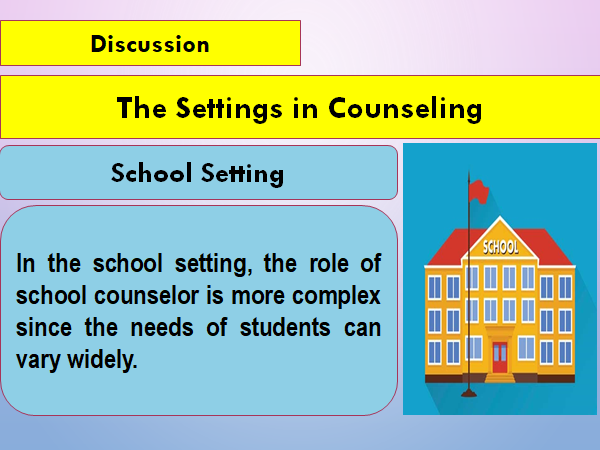The Settings, Processes, Methods, and Tools in Counseling
Counselors work in various settings- from government to private sectors, to civil society to school setting. Drawing on a wide range of processes, methods, and tools, counselors are trained to use what is appropriate for the setting and relative to their specialty. There are classical approaches informed by theories to counseling that scaffold their process and selection of methods and tools.
Counseling Approaches
Psychoanalysis

- represented by Sigmund Freud
- a theory of personality, an approach to psychotherapy, and method of investigation founded by Sigmund Freud
- the assumption is that there are inner battles that are waged in a client that are directly responsible for the appearance of symptoms and behavioral problems
- emphasizes the role of early childhood experiences
- early childhood experiences: dictate us of who we are as an adult
Behaviorism
- behavior and mental processes are determined by our environment
- all psychological disorders are a result of maladaptive learning that all behavior is learnt from our environment and symptoms are acquired through classical and operant conditioning
- Classical conditioning – involves learning by association; introduced by Ivan Pavlov
- Operant conditioning – involves learning by reinforcement; introduced by B.F. Skinner
The therapeutic techniques used in this type of treatment are action-based and rooted in the theories of classical conditioning and operant conditioning and utilize the same learning strategies that led to the formation of unwanted behaviors. Behavioral therapy tends to be highly focused on teaching clients new behaviors to minimize or eliminate the issue.
Humanistic Perspective
- behavior and mental processes are determined by our need to fulfill our potential

- attempted to understand the conscious mind, free will, human dignity, and the capacity for self-reflection and growth
- the human potential for change requires only exercise of the distinctively human capacities for choice, creativity, and drive toward self-actualization
- humanistic therapeutic models are rooted in insight and focus on self-development, growth, and responsibilities
- they seek to gain self-empowerment by recognizing their strengths, creativity and choice in the given circumstances
Review. Let’s see how far have you learned from this lesson by identifying the counseling approaches used by the counselors in the following situations.
- As a counselor, Alyana always believes in the capacity of her client to determine his own destiny and give meaning to his life.
- In dealing with his clients, Cardo always applies the talk therapy and actively listens to whatever his client is telling him.
- Flora, an adolescent counselor, explores the early experiences of her client in order to identify the underlying causes of the manifested behavior.
- Agatha coordinates with dream experts to examine the dreams and its relation to her client’s experiences.
- As a school counselor, Ericka uses reinforcements to modify the unwanted behaviors of her student-clients.
The Settings in Counseling
- Government Setting – Work with the various government agencies that have counseling services such as social welfare, correctional department, the court system, child and women affairs services, military, police, hospitals, foster homes, and rehabilitation centers.
- Private Sectors Setting – Counselors range from independent providers of services or work for NGOs, or specialized for profit centers and organizations that render a variety of counseling services.
- Civil Society Setting – The context of civil society is generally charities or non-profit and issue-based centers or organizations such as for abused women, abandoned children and elderly, veterans, teachers, professionals or religious groups.
- Community Setting – Has the greatest and widest application of counseling services considering the diversity of people. There are people who are in conflict with the law, socially marginalized, people who suffer loss of all kind, those living in institutional homes, and those experiencing different life transitions.
- School Setting – In the school setting, the role of school counselor is more complex since the needs of students can vary widely.





Tara! Let’s Review! Identify the setting where counselors work based from the following situations.
- Romina is a licensed professional counselor and works with the various government agencies that provide counseling services especially to correctional departments and child and women affairs services.
- Cassie works in a charitable institution for abandoned children and abused women.
- Savannah works in a non-profit-oriented/non-government organization that renders a variety of counseling services.
- Daniella is working in a public educational institution as a counselor. She provides various services to students and assumes many different responsibilities and tasks based on the particular needs of their clients.
- Marga provides counseling services to people who are in conflict with the law and socially marginalized individuals and groups.
Source: Disciplines and Ideas in the Applied Social Sciences, Elias M. Sampa. 2017 by Rex Book Store, pp. 49-54.
photo credits from ppt: http://www.google.com